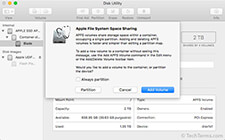Partition
A partition is a section of a storage device, such as a hard disk drive or solid state drive. It is treated by the operating system as a separate logical volume, which makes it function similarly to a separate physical device.
A storage device may be formatted with one or more partitions. Some operating systems, such as Windows and Linux require multiple partitions, while others, like macOS may only require one. Windows stores system files in a "System Partition" and user data files in a data partition. Some Windows drives may also include a "Recovery Partition," which stores files used by the Windows Recovery Environment (WinRE). This partition is used to repair problems that prevent the operating system from booting.
When formatting a storage device with a disk utility, you can either use the default partition scheme or create a custom one. For example, you could format a 2 TB hard drive with three partitions — a 300 GB partition used for the startup disk, a 700 GB partition for your photo library, and a roughly 1 TB partition for the rest of your data. These partitions would each appear as separate volumes on your computer even though they are all on one physical disk. You can mount and unmount any partitions besides the startup disk.
Why Partition a Disk?
Partitioning a disk can make it easier to organize files, such as video and photo libraries, especially if you have a large hard drive. Creating a separate partition for your system files (the startup disk) can also help protect system data from corruption since each partition has its own file system. For many years it was advisable to partition hard drives to reduce the minimum sector size and increase performance. However, with modern file systems and faster HDDs and SSDs, creating multiple partitions no longer has the same benefit.
Older operating systems only allowed you to partition a disk during the formatting or reformatting process. This meant you would have to reformat a hard drive (and erase all of your data) to change the partition scheme. Modern operating systems and disk utilities now allow you to resize partitions and create new partitions or volumes on-the-fly. For example, Apple's APFS file system supports resizing partitions and creating new volumes without reformatting.
 Test Your Knowledge
Test Your Knowledge